The Intel Haswell-E CPU Review: Core i7-5960X, i7-5930K and i7-5820K Tested
by Ian Cutress on August 29, 2014 12:00 PM ESTOverclocked Results
As part of our reviews here at AnandTech we have recently been including a section on overclocked results, because in the end a +10% overclock does not always mean an extra +10% on performance. For our overclocking escapades mentioned earlier in the review, while we were able to achieve 4.6 GHz on the Core i7-5960X, the sweet spot was around 4.3 GHz at a very comfortable temperature. This leads to a +43% overclock over the base frequency, similar to what we saw with Sandy Bridge-E overclocking.
For our overclocking tests, we are using the same graphs as in the last two pages, but adding the data from our overclocked Sandy Bridge-E, Ivy Bridge-E, Haswell and Haswell-E CPUs as well, tested fresh for this review on our latest benchmark suite.
In the past overclocking was all about getting the same or better performance for a lower cost, however with Ivy Bridge-E due to its lower frequency, it was a battle to keep on par with Sandy Bridge-E. Now that Haswell-E has the same frequency deficit (200 MHz) but a +8% increase in IPC, it begs the question if Sandy Bridge-E users with good 4.8 GHz+ CPUs should consider upgrading (for anything other than more cores and an upgraded chipset).
SYSmark 2014

SYSmark sees the biggest uplift in its media and office benchmark suites when overclocked, although the financial suite does enjoy the more cores to put the 5960X ahead.
HandBrake v0.9.9: link
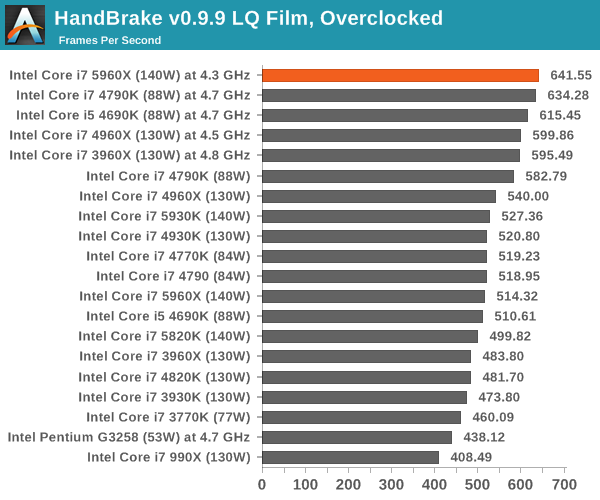
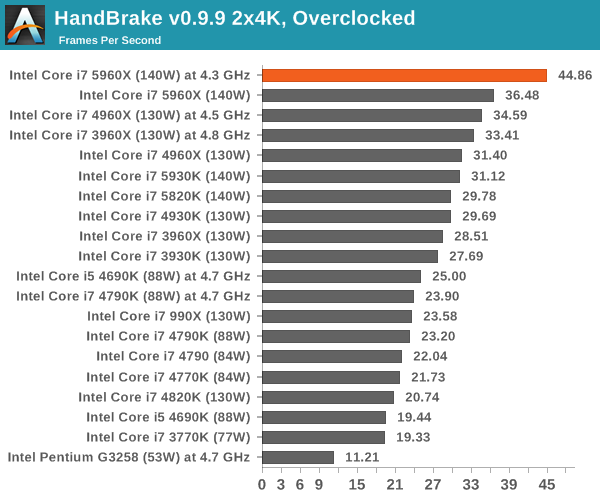
Interestingly the overclocked 5960X does aid low quality conversion, showing that with enough frequency all the cores can be constantly fed with data. The 5960X takes the top two spots for 4K conversion.
Agisoft Photoscan – 2D to 3D Image Manipulation: link

Photoscan also enjoys overclocking in combination with the cores, but the 3960X overclocked will beat the 5960X at stock despite the extra cores of the 5960X.
Dolphin Benchmark: link
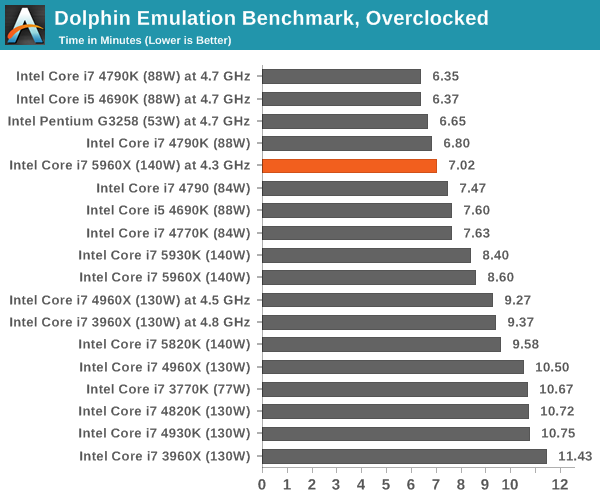
Dolphin prefers single threaded speed, so the Haswell CPUs at 4.7 GHz win here. Haswell does well in Dolphin's emulation overall, hence why the older extreme processors, even when overclocked, are further down.
WinRAR 5.0.1: link
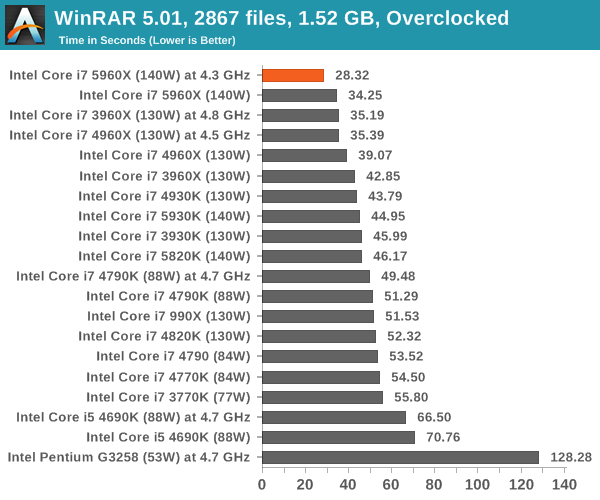
More top spots for the 5960X, with the two extra cores at stock beating the other extreme processors.
Hybrid x265
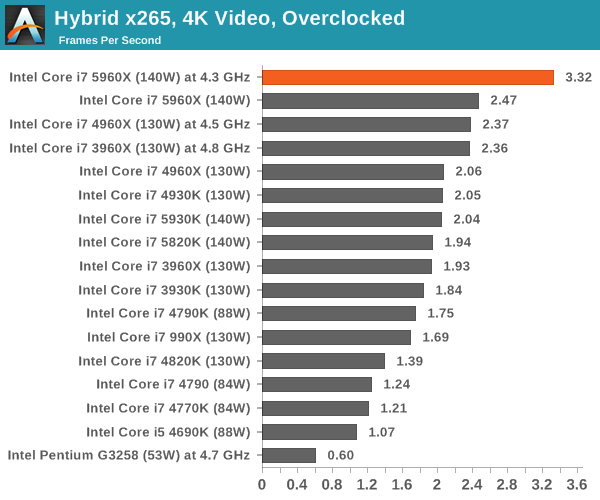
Cinebench R15
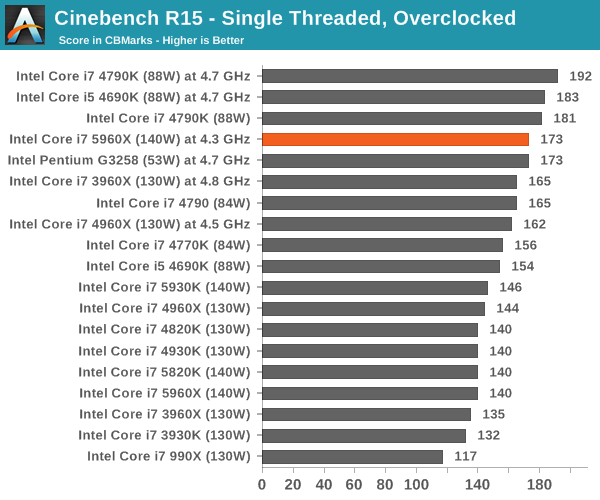
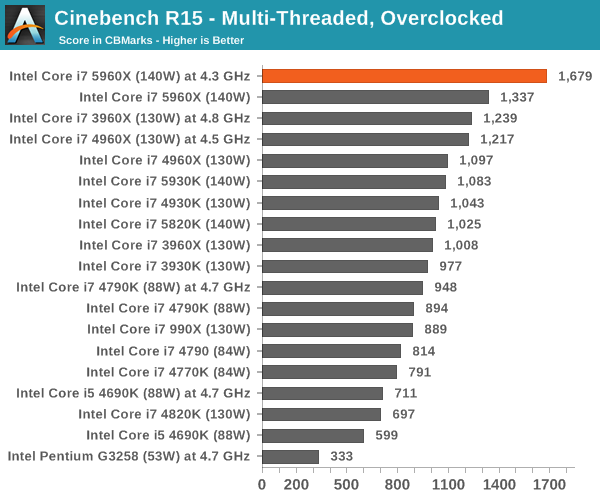
3D Particle Movement
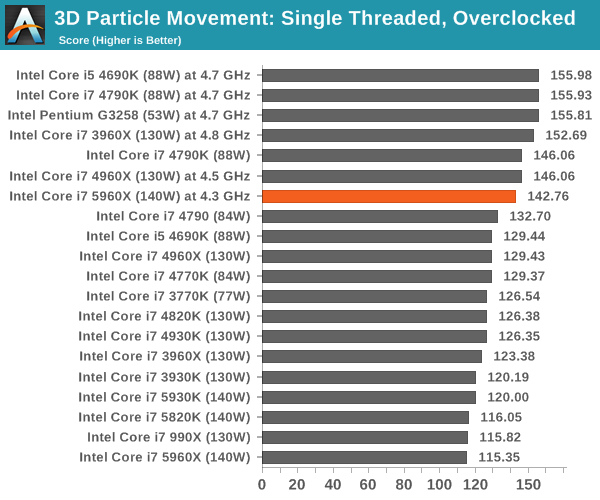
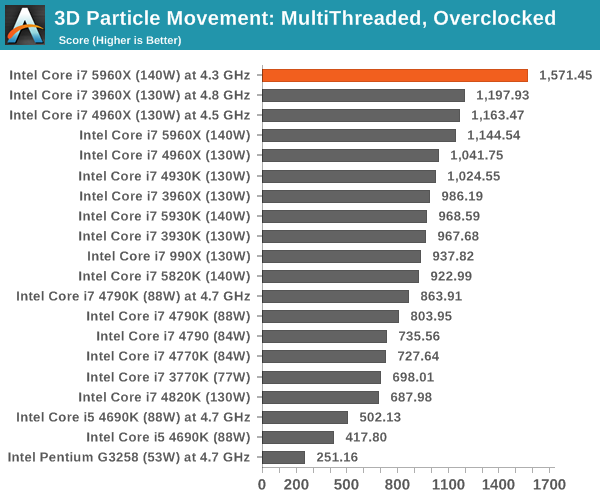
FastStone Image Viewer 4.9

When overclocked to 4.3 GHz, the 5960X would seem to produce a similar experience in FastStone to the 4790K at stock. This makes sense as the 4790K at stock is 4.4 GHz in turbo mode.
POV-Ray 3.7 Beta RC14
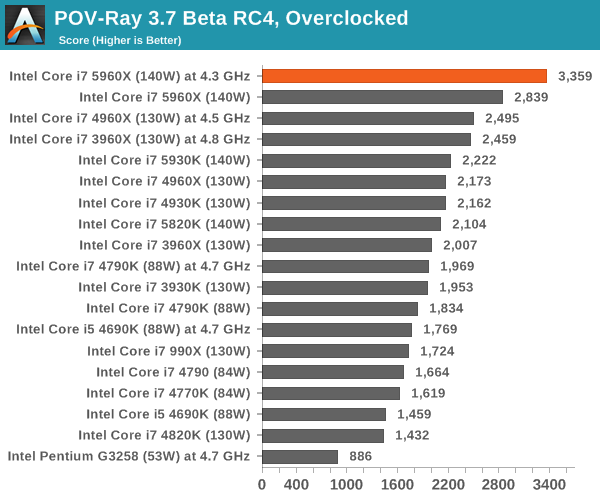
Gaming Benchmarks
F1 2013

The overclocked 5960X scores a few points in minimum frame rates, giving another +20% while in SLI.
Bioshock Infinite
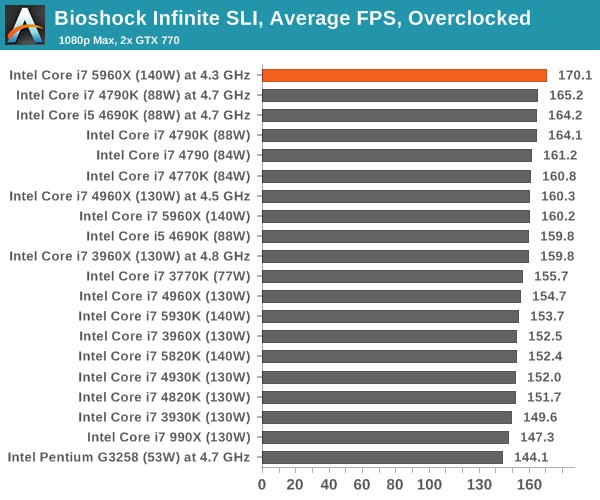
Bioshock average frame rates seem to get a small boost when overclocked, but minimum frame rates are more responsive to the 84W and 88W parts. The variation might be more indicative of the benchmark as a whole, as it only takes one errant slow frame to produce a low result in the minimum FPS results.
Tomb Raider
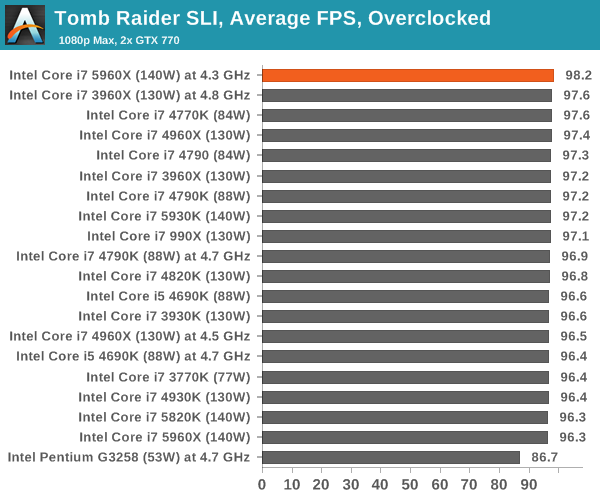
Sleeping Dogs
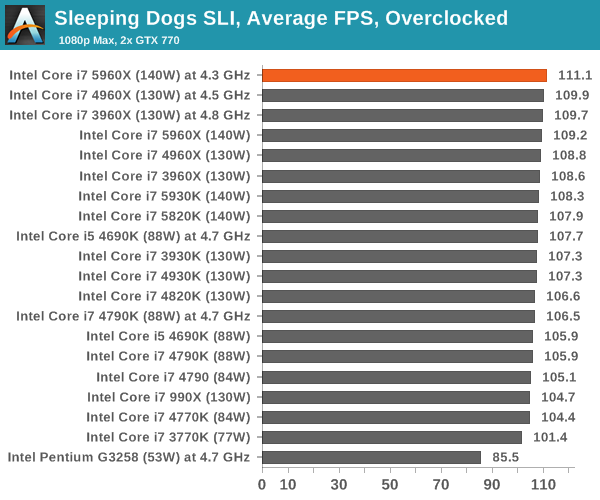
Battlefield 4
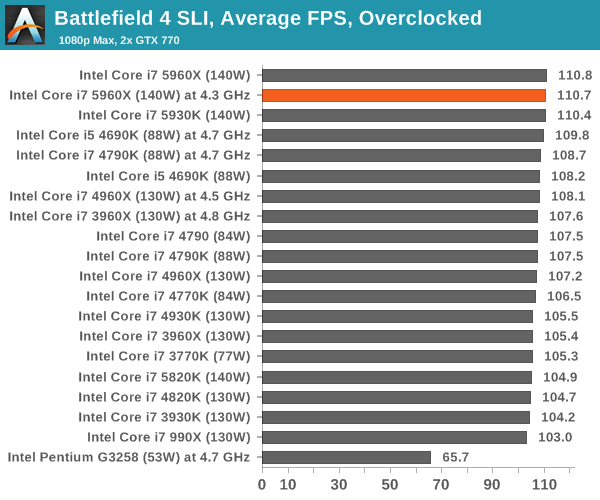
















203 Comments
View All Comments
Michael REMY - Friday, August 29, 2014 - link
again, in your table of extreme core i7 cpus, you forgot the last 4-core Nehalem which is : the i7-975X at 3.3GHz .No, the 965X is not the latest 4-core extreme !
Death666Angel - Friday, August 29, 2014 - link
Considering this would have cost me ~340€ over my i7-4770K (which I have @ 4.5GHz and delidded), because of the price difference in CPU and the fact that I had a 1150 socket mainboard from my retired mining rig, I'm not too salty about it. At least it is 6 core at the low end, that is encouraging. I've been mostly fine with my i7-860 so I guess the i7-4770k will serve me a while.Death666Angel - Saturday, August 30, 2014 - link
"With ASUS motherboards, they have implemented a new onboard button which tells 2x/3x GPU users which slots to go in with LEDs on the motherboard to avoid confusion."Because looking stuff up in the manual is way too complicated!
anactoraaron - Friday, August 29, 2014 - link
The 5820 can be had for $299 at micro center and they will also discount a compatible motherboard by $40. Jus' sayin'. IDK if there's some kind of ad agreement, etc for listing Newegg's price... Anyone shopping for anything should always shop around.tuxRoller - Friday, August 29, 2014 - link
"Very few PC games lose out due to having PCIe 3.0 x8 over PCIe 3.0 x16"Any? Even BF4 might be more due to other factors. It might be more useful to determine these bottlenecks with uhd.
Ian Cutress - Monday, September 1, 2014 - link
I want to try with UHD. Need the monitors though.Mr Perfect - Friday, August 29, 2014 - link
I realize you where trying to CPU limit the benchmarks by using such a low resolution, but does this still hold up when running, say, three 1440p monitors? Wouldn't that be the time when the GPUs are maxed out and start shuttling large amounts of data between themselves?
Ian Cutress - Monday, September 1, 2014 - link
I want to test with higher resolutions in the near future, although my monitor situation is not as fruitful as I would hope. There is no big AnandTech warehouse, we all work in our corner of the world so shipping around this HW is difficult.KAlmquist - Friday, August 29, 2014 - link
"The move to DDR4 2133 C15 would seem to have latency benefits over previous DDR3-1866 and DDR3-1600 implementations as well."If my math is correct, this is wrong. With DDR4 2133 timings of 15-15-15, each of those 15's corresponds to 14.1 nanoseconds. (Divide 2133 by two to get the actual frequency, then divide the clock count by the frequency.) With DDR3 1600 and the common 9-9-9 timings, each time is only 11.25 nanoseconds. With DDR3, the actual transfer of the data takes four clock cycles (there are eight transfers, but "DDR" stands for "double data rate" meaning that there are two transfers per clock cycle). That translates to 5 nanonseconds on DDR3 1600. DDR4 transfers twice as much data at a time, so with DDR4 2133 a transfer takes eight clock cycles or 7.5 nanoseconds. So DDR3 1600 has lower latency than the DDR4 2133 memory.
So why does Sandra report a memory latency of around 28.75 nanoseconds (92 clock cycles at 3.2 Ghz) as shown in the chart on page 2 of this review? If a bank does not have an open page, then the memory latency should be 15+15+8 clock cycles, or 35.6 nanoseconds, not counting the latency internal to the processor. So the Sandra benchmark result seems implausible to me. As far as I can tell, the source code for the Sandra benchmark is not available so there is no way to tell exactly what it is measuring.
JumpingJack - Monday, September 1, 2014 - link
Good points.